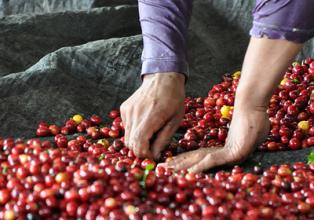Taste characteristics of fermented natural sun-cured Ethiopian coffee varieties introduction to the flavor of fine coffee beans in the manor
Ethiopia is blessed with natural conditions for growing all conceivable varieties of coffee. Ethiopia's coffee beans are mainly grown as highland crops in areas with altitudes of 1100-2300 meters above sea level, roughly distributed in southern Ethiopia. Deep, well drained soils, slightly acidic soils, lateritic soils, and soft, loamy soils are suitable for growing coffee beans because they are rich in nutrients and have an adequate supply of humus. Rainfall is evenly distributed during the seven-month rainy season; fruit grows from flowering to fruiting and crops grow 900-2700 mm per year during the plant growth cycle, while temperatures fluctuate between 15 ° C and 24 ° C throughout the growth cycle.
The bulk of coffee production (95%) is done by small shareholders, with an average yield of 561 kg/ha. For centuries, small shareholders of Ethiopian coffee farms have been producing a variety of high-quality coffee types. The secret to producing good coffee is that coffee farmers have developed a coffee culture under suitable conditions through generations of repeated learning of the coffee growing process, which mainly consists of farming methods using natural fertilizers, picking the reddest and fully ripe fruits and processing them in clean conditions. Ethiopian coffee varies in quality, nature, and variety due to differences in elevation, region, location, and even land type. Ethiopian coffee beans are unique due to their natural characteristics, including "size of coffee beans,""shape,""acidity,""quality,""flavor" and "aroma." These characteristics give Ethiopian coffee its unique natural qualities, and Ethiopia usually acts as a "coffee supermarket" for customers to choose from.
Ethiopia's total coffee production ranges from 200,000 to 250,000 tons per year. Today Ethiopia is one of the largest coffee producers in the world, ranking 14th in the world and 4th in Africa.
Sustainable coffee culture
Ethiopian coffee beans grow in a near-natural environment. After years of cultivation under the same growing conditions, Ethiopian coffee beans have gradually adapted to the environment here. More than 60% of coffee beans are forest or semi-forest grown coffee.
Coffee farming villages produce about 35 percent of the country's coffee. These coffee farms, which use a multi-tiered coffee growing system, are carefully cared for. Coffee farmers do not use chemical fertilizers, but use fallen leaves, plant and animal debris to increase soil nutrients. In addition to coffee, farmers also frequently grow non-coffee crops. Even manor coffee (coffee produced on state farms), which accounts for 5% of the country's coffee production, exhibits forest-type coffee production characteristics.
Located in the most privileged natural conditions, Ethiopia produces unique high-quality coffee every year. Ethiopia's coffee growing cycle brings harvest joy to the country every year. Beautiful white coffee flowers bloom and bear fruit every year between March and April. Only the reddest and most mature fruits are selected for coffee between September and about December. The export of fresh coffee begins in November or December of each year.
Coffee Flavor Profile
Ethiopia has unique and distinctive flavors, offering a wide range of flavors to customers around the world.
In the southwestern highlands of Ethiopia, the Kaffa, Sheka, Gera, Limu and Yayu Senli coffee ecosystems are considered home to Arabica coffee. These forest ecosystems are also home to a variety of medicinal plants, wildlife and endangered species.
Ethiopia's western highlands have bred new coffee varieties that resist fruit disease or leaf rust. Ethiopia is known for its many coffee types. Some of the major coffee types are known for their unique aromas and flavors, including the following:
Limu Coffee
This coffee is grown at altitudes ranging from 1400 to 2000 meters. This coffee is wet processed and has a strong aroma; the fruit is full and the pH is moderate; the quality is excellent and the spicy flavor is attractive. It is estimated that the average annual production of this coffee is 29000 tons (equivalent to 480,000 bags of 60 kg coffee) out of 49000 hectares of cultivated area.
Djimma Coffee
- This coffee is grown at altitudes ranging from 1400 to 1800 meters. This coffee is natural or sun coffee; weak to medium acid, full fruit, good average quality; rich aroma; a drop in the mouth, aftertaste endless. It is estimated that the average annual production of this coffee is 70000 tons (equivalent to 1.17 million bags of 60 kg coffee) out of 127000 hectares of cultivated area.
Yirgachefe Coffee--
This coffee is grown at altitudes ranging from 1500 to 2200 meters. The coffee is washed in clear streams, hand-picked and fully sun-washed. The taste is unique; the fruit is medium-sized and comparable to mocha. Taste mellow, unique charm, give people a sense of refreshing, optimistic market prospects. It is estimated that the average annual production of this coffee is 28000 tons (equivalent to 470,000 bags of 60 kg coffee) out of 42000 hectares of cultivated area.
Sidamo coffee--
The coffee is grown on the shoulder slopes of the East African Rift Valley at altitudes ranging from 1400 to 2200 meters. Natural (sun) and washed coffee is unique in quality, moderate in pH and excellent in quality. It is estimated that the average annual production of this coffee is 37000 tons (equivalent to 620,000 bags of 60 kg coffee) out of 61000 hectares of cultivated area.
Harar coffee--
This coffee is grown in areas ranging from the Darolebu plains at an altitude of 900 meters to the Chercher mountains in Ethiopia's eastern highlands at an altitude of 2700 meters. These mountains do provide unique characteristics to these perennial coffee beans: full, elongated fruit, moderate acidity, and typical mocha flavor. Harar Coffee The world's leading quality coffee; although the variety is produced abroad, it gives a warm feeling, smooth and sweet taste, giving people the rich taste of real mocha coffee. It is estimated that the average annual production of this coffee is 26000 tons (equivalent to 430,000 bags of 60 kg coffee) out of 52000 hectares of cultivated area.
Quality and supply assurance
On coffee farms, high quality assurance is reflected in the timely and rigorous selection of ripe and reddest coffee fruits. The coffee needs to be protected from direct sunlight and the fruit collected in bamboo baskets to avoid contact with the soil.
The harvested fruit is washed in clean water and stored underwater to enhance the flavor and color of the coffee beans. The processing process begins with hand selection, machine washing and pulping of the fruit on harvest day, followed by natural fermentation and sun exposure to achieve optimum moisture levels. After machine processing, the beans are painstakingly and carefully hand-selected and packaged. This processing takes place in regular home factories with modern equipment and operating permits, and is finally manually graded and stored in well-equipped warehouses. Ethiopia exports high quality coffee to all parts of the world every year. Ethiopia pursues strict quality assurance measures, including visual inspection and taste tasting, to ensure zero defects in export quality, full fruit and rich aroma.
Characteristics of the Ethiopian Coffee Market
Ethiopia's coffee market regulator is the Ethiopian Coffee and Tea Products Authority. There are two auction centers in the country, one in Addis Ababa and the other in Dire Dawa in eastern Ethiopia. Coffee farmers bring fresh fruit either to private coffee processing plants or to cooperative coffee washing stations for washing. After washing and drying, the beans are transported to a central store in Addis Ababa, where they are thoroughly inspected and steeped, graded for poor quality and auctioned off. Coffee grown on state farms follows the same procedure after farm processing. Auction buyers scrutinize the beans and proof of steeping before bidding. Bidding takes the form of buyers shouting out bids.
Ethiopian coffee exports
Ethiopia exports 80 - 85 per cent of natural or sun-cured coffee beans and 15 - 20 per cent of wet-processed coffee beans annually. Ethiopia has an estimated 2.5 percent market share in the global coffee market. Ethiopia's coffee exports to all parts of the world, Germany, Japan, Saudi Arabia and the United States are Ethiopia's four major coffee export countries. On average, Ethiopia exports approximately 109,000 tons of coffee (equivalent to 1.8 million 60 kg bags of coffee) worldwide each year.
Transportation of high quality coffee beans
Coffee is an important industry in Ethiopia. Ethiopia is not only a symbol of coffee, but also a prosperous economic development based on coffee exports. Not only that, Ethiopia as a whole also loves drinking coffee.
Ethiopians love coffee, with an annual per capita coffee consumption of 3 kg. Ethiopia ranks first in coffee consumption in Africa and, if compared to European countries, is also in the middle and upper ranks of European coffee consuming countries.
Ethiopia now produces coffee not only for drinking, but for coffee lovers all over the world to enjoy. As the coffee industry continues to improve in quality and productivity, Ethiopia is now better able than ever to deliver high-quality coffee to even the most discerning and discriminating customers. Ethiopia hopes that not only the coffee consuming countries of the world but also the Chinese people can share in Ethiopia's precious wealth. Because the Chinese people have gradually become the "experts" who appreciate the quality of coffee.

Important Notice :
前街咖啡 FrontStreet Coffee has moved to new addredd:
FrontStreet Coffee Address: 315,Donghua East Road,GuangZhou
Tel:020 38364473
- Prev

Wine-scented Aldumara Coffee varieties taste characteristics Manor boutique coffee bean flavor introduction
Mexico: Aldura coffee flavor taste characteristics: soft aroma, mellow and comfortable, with wine aroma. Mexico has a long history of producing coffee and is currently one of the most important coffee producing countries in the world. The coffee produced in Mexico is naturally called Mexican coffee. About 5 ℃ of the total area of Mexico are plateaus and mountains, with an annual average temperature of 2527 ppm.
- Next

Taste characteristics of Jamaican coffee varieties with small but fine output introduction to the flavor of boutique coffee beans in the manor
Coffee is grown outside the Blue Mountains and is called Jamaican coffee. It turns out that people in the coffee industry in China generally have a wrong understanding that only coffee grown in the Blue Mountain area above 1800 meters above sea level can be called Blue Mountain Coffee. In fact, there is only one manor on the top of the Blue Mountain Mountains above 1800, that is, Amber, which is of Chinese descent. The owner of the manor is surnamed Lyn (Lin) and is of Chinese origin.
Related
- Detailed explanation of Jadeite planting Land in Panamanian Jadeite Manor introduction to the grading system of Jadeite competitive bidding, Red bid, Green bid and Rose Summer
- Story of Coffee planting in Brenka region of Costa Rica Stonehenge Manor anaerobic heavy honey treatment of flavor mouth
- What's on the barrel of Blue Mountain Coffee beans?
- Can American coffee also pull flowers? How to use hot American style to pull out a good-looking pattern?
- Can you make a cold extract with coffee beans? What is the right proportion for cold-extracted coffee formula?
- Indonesian PWN Gold Mandrine Coffee Origin Features Flavor How to Chong? Mandolin coffee is American.
- A brief introduction to the flavor characteristics of Brazilian yellow bourbon coffee beans
- What is the effect of different water quality on the flavor of cold-extracted coffee? What kind of water is best for brewing coffee?
- Why do you think of Rose Summer whenever you mention Panamanian coffee?
- Introduction to the characteristics of authentic blue mountain coffee bean producing areas? What is the CIB Coffee Authority in Jamaica?

